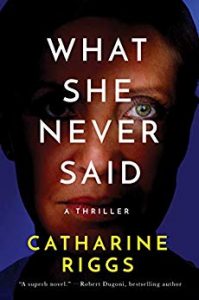Running to the Muse
 I once attended a ThrillerFest conference featuring author John Sandford, who offered some basic advice: “Write. Just write.” I’m paraphrasing here but essentially he said, “When you treat writing as a job, there’s no time for writer’s block.” The prolific novelist is 74, has won a Pulitzer Prize in journalism, and produces an average of three novels a year.
I once attended a ThrillerFest conference featuring author John Sandford, who offered some basic advice: “Write. Just write.” I’m paraphrasing here but essentially he said, “When you treat writing as a job, there’s no time for writer’s block.” The prolific novelist is 74, has won a Pulitzer Prize in journalism, and produces an average of three novels a year.
After the lecture, I attended his book signing where he grilled me on my process and then repeated his earlier words. “Approach writing as a business. Just write.” His admonition struck a chord. I began writing later in life and it took nearly fifteen years before Thomas & Mercer published my debut thriller, What She Gave Away, with the sequel, What She Never Said, due out this September. It took me so long to get my writing career launched, I’m reluctant to let a single hour slip away.
In no way am I on John Sandford’s schedule; I have a goal of one novel per year. But I have developed a number of techniques to keep me on track because, like most writers, there are days when the words don’t flow. When a single phrase can keep me fixated for hours, unable to unravel the mystery in the words. And as a seat-of-the-pants writer, there are times when the plot seems to have worked its way into a dead end. Days where I can’t see the forest for the trees. Where I am one hundred percent certain my writing is terrible, my plot a twisted mess, my characters flat on the page.
So I have had to develop a number of tools to help me access my inner muse. First and foremost is to write in the early morning hours when I am at my most creative and my words are not constrained by more rational thoughts. To take full advantage of this magical time, I arrive at my desk with coffee in hand by five each morning. I write for two, sometimes three hours until the window of opportunity closes and the words no longer flow.
But with so many hours left in the day, it seems a waste to fritter them away. So years ago I discovered running as a means to recharge my mind and allow the muse to continue her work. Somewhere around seven each morning, I head out on a three- to six-mile run. In that short period of time, with endorphins churning, not only is my writing day reset, but I typically have straightened out one or more problems with my work-in-progress. In fact, I often run with a small notebook so I can jot down an idea or solution and free up room for the next one to emerge.
I began running in my early twenties when I moved to Des Moines, Iowa, to pursue an MBA. I had been a tennis player for most of my life, but when winter rolled around I couldn’t afford the price to play indoors and was open to a less expensive alternative. This was before marathons were common and when winter street running was considered extreme, yet each year the local Drake Relays organized a marathon for the diehards. When a friend asked if I would train with him for the springtime event I thought, why not?
I was not a runner before I made that commitment. In fact, I had dreaded the single mile my college tennis coach forced upon the team before our daily practice. But I also hated the idea of being cooped up all winter and not pursuing a sport. So I bought a pair of running shoes and a leather hockey mask for days when the temperature dipped below zero. Then I researched a marathon training schedule and started in on the sport that would become a constant in my life.
The running was terrible at first, my lungs screaming for air, my legs demanding to rest. There was ice on the roads, frostbite in the air. But I stubbornly chased my goal, and after a few weeks found myself falling into a rhythm. By the time I crossed the finish line of my first marathon, I was hooked. Except for a few short breaks taken for injuries and pregnancies, I have hit the road daily ever since.
Running pulled me out of the depression I suffered in my twenties. It soothed the pressures of early motherhood, the stresses of various jobs, the sadness of parents dying and friends moving away. And more recently, running has become a way to access my inner muse.
I don’t train with a group or run with a watch. When I head out the door, I let my body dictate how far I should go. Usually within a mile, the mental clouds part and my restless mind begins to slow. Insurmountable problems become molehills, hidden answers become clear. I don’t give myself an obstacle and demand it be solved. Rather, I attempt to silence my inner chatter and let my mind wander where it wants. Sometimes that means the rewriting of a single sentence so the sentiment rings true. Other times are more dramatic, like when one of my first-person point of view characters insist on a new ending to a scene.
I am not suggesting that all writers should attempt to access their muse in the same way. What I am suggesting is that any writer would do well to heed John Sandford’s advice: “Just write.” Developing tools to accomplish this feat can only help in achieving one’s goals. That “tool” may be a walk or a swim or listening to music. Or possibly, a period of meditation or climbing a fifty-foot wall. Whatever it is, seek out the key to recharge your workday and use it to achieve your goals.
—
Catharine Riggs lives and writes on California’s central coast. Before turning to fiction writing, Riggs worked as a business banker, an adjunct college instructor, and a nonprofit executive. What She Gave Away is the first novel in her Santa Barbara Suspense series. Thomas & Mercer will launch the second, What She Never Said, in September of 2019.
Visit the author online at www.catharineriggs.com. Email her at catharine@catharineriggs.com.
Connect with her at:
https://twitter.com/
https://www.instagram.com/
https://goodreads.com/
WHAT SHE NEVER SAID
Coming in September of 2019. What She Never Said. What would you pay to keep a secret?
People are dying at a luxury retirement community . . . and not from natural causes.
Ruth Mosby is the VP of operations at Serenity Acres, where the privileged elite go to die. For a hefty fee, wealthy retirees can live the good life in this posh Santa Barbara community—even after they outlive their money. Ruth thinks this is a fine arrangement, but the savvy new boss has a new rule: if you can’t pay, you can’t stay.
Ruth is deeply disturbed when destitute residents start dying at an alarming rate, as if on cue. Even more troubling, a macabre note accompanies each departed guest. Surviving guests whisper about an “Angel” who assists with suicides. Ruth has another word for it: murder.
Ruth enlists her neighbor, an ex-detective named Zach, to discover the Angel’s secret identity. However, the two have a painful history, and Ruth has dark secrets all her own. To solve the mystery, Ruth must descend from her golden tower—but can she bear the consequences of revealing her own sinister truths?
Category: Contemporary Women Writers, How To and Tips






























